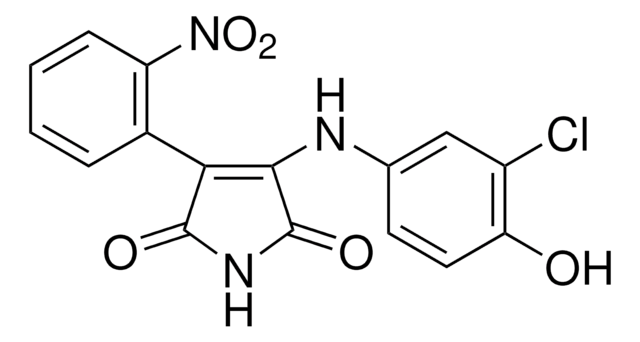A4847
Alsterpaullone
≥98% (HPLC), powder
Sinónimos:
9-Nitro-7,12-dihydroindolo-[3,2-d][1]benzazepin-6(5)-one
About This Item
Productos recomendados
Ensayo
≥98% (HPLC)
Formulario
powder
condiciones de almacenamiento
desiccated
color
yellow to brown
solubilidad
DMSO: ≥10 mg/mL
temp. de almacenamiento
2-8°C
cadena SMILES
[O-][N+](=O)c1ccc2[nH]c-3c(CC(=O)Nc4ccccc-34)c2c1
InChI
1S/C16H11N3O3/c20-15-8-12-11-7-9(19(21)22)5-6-14(11)18-16(12)10-3-1-2-4-13(10)17-15/h1-7,18H,8H2,(H,17,20)
Clave InChI
OLUKILHGKRVDCT-UHFFFAOYSA-N
Información sobre el gen
rat ... Gsk3b(84027)
Aplicación
Acciones bioquímicas o fisiológicas
Características y beneficios
Código de clase de almacenamiento
11 - Combustible Solids
Clase de riesgo para el agua (WGK)
WGK 3
Punto de inflamabilidad (°F)
Not applicable
Punto de inflamabilidad (°C)
Not applicable
Equipo de protección personal
dust mask type N95 (US), Eyeshields, Gloves
Elija entre una de las versiones más recientes:
¿Ya tiene este producto?
Encuentre la documentación para los productos que ha comprado recientemente en la Biblioteca de documentos.
Nuestro equipo de científicos tiene experiencia en todas las áreas de investigación: Ciencias de la vida, Ciencia de los materiales, Síntesis química, Cromatografía, Analítica y muchas otras.
Póngase en contacto con el Servicio técnico







